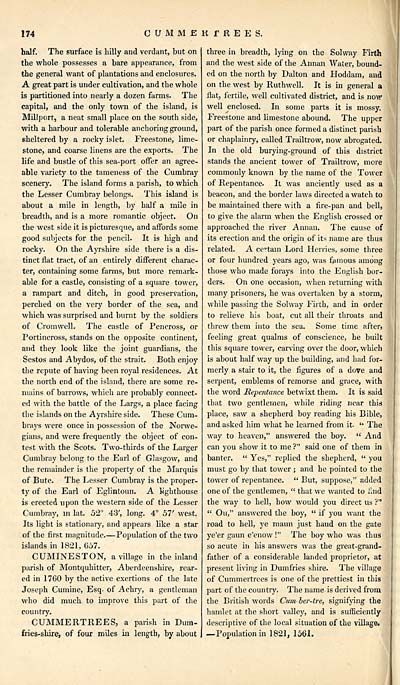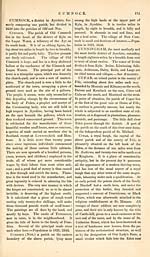Gazetteer of Scotland > Volume 1
(202) Page 174 - CUM
Download files
Complete book:
Individual page:
Thumbnail gallery: Grid view | List view

174
CUMMSKf REES.
half. The surface is hilly and verdant, but on
the whole possesses a bare appearance, from
the general want of plantations and enclosures.
A great part is under cultivation, and the whole
is partitioned into nearly a dozen farms. The
capital, and the only town of the island, is
Millport, a neat small place on the south side,
with a harbour and tolerable anchoring ground,
sheltered by a rocky islet. Freestone, lime-
stone, and coarse linens are the exports. The
life and bustle of this sea-port offer an agree-
able variety to the tameness of the Cumbray
scenery. The island forms a parish, to which
the Lesser Cumbray belongs. This island is
about a mile in length, by half a mile in
breadth, and is a more romantic object. On
the west side it is picturesque, and affords some
good subjects for the pencil. It is high and
rocky. On the Ayrshire side there is a dis-
tinct flat tract, of an entirely different charac-
ter, containing some farms, but more remark-
able for a castle, consisting of a square tower,
a rampart and ditch, in good preservation,
perched on the very border of the sea, and
which was surprised and burnt by the soldiers
of Cromwell. The castle of Pencross, or
Portincross, stands on the opposite continent,
and they look like the joint guardians, the
Sestos and Abydos, of the strait. Both enjoy
the repute of having been royal residences. At
the north end of the island, there are some re-
mains of barrows, which are probably connect-
ed with the battle of the Largs, a place facing
the islands on the Ayrshire side. These Cum-
brays were once in possession of the Norwe-
gians, and were frequently the object of con-
test with the Scots. Two-thirds of the Larger
Cumbray belong to the Earl of Glasgow, and
the remainder is the property of the Marquis
of Bute. The Lesser Cumbray is the proper-
ty of the Earl of Eglintoun. A lighthouse
is erected upon the western side of the Lesser
Cumbray, in lat. 52° 43', long. 4° 51' west.
Its light is stationary, and appears like a star
of the first magnitude. — Population of the two
islands in 1821, 657.
CUMINESTON, a village in the inland
parish of Montquhitter, Aberdeenshire, rear-
ed in 1760 by the active exertions of the late
Joseph Cumine, Esq. of Achry, a gentleman
who did much to improve tins part of the
country.
CUMMERTREES, a parish in Dum-
fries-shire, of four miles in length, by about
three in breadth, lying on the Sol way Firth
and the west side of the Annan Water, bound-
ed on the north by Dalton and Hoddam, and
on the west by Ruthwell. It is in general a
flat, fertile, well cultivated district, and is now
well enclosed. In some parts it is mossy.
Freestone and limestone abound. The upper
part of the parish once formed a distinct parish
or chaplainry, called Trailtrow, now abrogated.
In the old burying-ground of this district
stands the ancient tower of Trailtrow, more
commonly known by the name of the Tower
of Repentance. It was anciently used as a
beacon, and the border laws directed a watch to
be maintained there with a fire-pan and bell,
to give the alarm when the English crossed or
approached the river Annan. The cause of
its erection and the origin of its name are thus
related. A cctain Lord Hemes, some three
or four hundred years ago, was famous among
those who made forays into the English bor-
ders. On one occasion, when returning with
many prisoners, he was overtaken by a storm,
while passing the Solway Firth, and in order
to relieve his boat, cut all their throats and
threw them into the sea. Some time after,
feeling great qualms of conscience, he built
this square tower, carving over the door, which
is about half way up the building, and had for-
merly a stair to it, the figures of a dove and
serpent, emblems of remorse and grace, with
the word Repentance betwixt them. It is said
that two gentlemen, while riding near this
place, saw a shepherd boy reading his Bible,
and asked him what he learned from it '• The
way to heaven," answered the boy. " And
can you show it to me ?" said one of them in
banter. " Yes," replied the shepherd, " you
must go by that tower ; and he pointed to the
tower of repentance. " But, suppose," added
one of the gentlemen, " that we wanted to find
the way to hell, how would you direct us ?"
" On," answered the boy, " if you want the
road to hell, ye maun just baud on the gate
ye'er gaun e'enow !" The boy who was thus
so acute in his answers was the great-grand-
father of a considerable landed proprietor, at
present living in Dumfries shire. The village
of Cummertrees is one of the prettiest in this
part of the country. The name is derived from
the British words Cum- ber-ire, signifying the
hamlet at the short valley, and is sufficiently
descriptive of the local situation of the village.
—Population in 1821, 1561.
CUMMSKf REES.
half. The surface is hilly and verdant, but on
the whole possesses a bare appearance, from
the general want of plantations and enclosures.
A great part is under cultivation, and the whole
is partitioned into nearly a dozen farms. The
capital, and the only town of the island, is
Millport, a neat small place on the south side,
with a harbour and tolerable anchoring ground,
sheltered by a rocky islet. Freestone, lime-
stone, and coarse linens are the exports. The
life and bustle of this sea-port offer an agree-
able variety to the tameness of the Cumbray
scenery. The island forms a parish, to which
the Lesser Cumbray belongs. This island is
about a mile in length, by half a mile in
breadth, and is a more romantic object. On
the west side it is picturesque, and affords some
good subjects for the pencil. It is high and
rocky. On the Ayrshire side there is a dis-
tinct flat tract, of an entirely different charac-
ter, containing some farms, but more remark-
able for a castle, consisting of a square tower,
a rampart and ditch, in good preservation,
perched on the very border of the sea, and
which was surprised and burnt by the soldiers
of Cromwell. The castle of Pencross, or
Portincross, stands on the opposite continent,
and they look like the joint guardians, the
Sestos and Abydos, of the strait. Both enjoy
the repute of having been royal residences. At
the north end of the island, there are some re-
mains of barrows, which are probably connect-
ed with the battle of the Largs, a place facing
the islands on the Ayrshire side. These Cum-
brays were once in possession of the Norwe-
gians, and were frequently the object of con-
test with the Scots. Two-thirds of the Larger
Cumbray belong to the Earl of Glasgow, and
the remainder is the property of the Marquis
of Bute. The Lesser Cumbray is the proper-
ty of the Earl of Eglintoun. A lighthouse
is erected upon the western side of the Lesser
Cumbray, in lat. 52° 43', long. 4° 51' west.
Its light is stationary, and appears like a star
of the first magnitude. — Population of the two
islands in 1821, 657.
CUMINESTON, a village in the inland
parish of Montquhitter, Aberdeenshire, rear-
ed in 1760 by the active exertions of the late
Joseph Cumine, Esq. of Achry, a gentleman
who did much to improve tins part of the
country.
CUMMERTREES, a parish in Dum-
fries-shire, of four miles in length, by about
three in breadth, lying on the Sol way Firth
and the west side of the Annan Water, bound-
ed on the north by Dalton and Hoddam, and
on the west by Ruthwell. It is in general a
flat, fertile, well cultivated district, and is now
well enclosed. In some parts it is mossy.
Freestone and limestone abound. The upper
part of the parish once formed a distinct parish
or chaplainry, called Trailtrow, now abrogated.
In the old burying-ground of this district
stands the ancient tower of Trailtrow, more
commonly known by the name of the Tower
of Repentance. It was anciently used as a
beacon, and the border laws directed a watch to
be maintained there with a fire-pan and bell,
to give the alarm when the English crossed or
approached the river Annan. The cause of
its erection and the origin of its name are thus
related. A cctain Lord Hemes, some three
or four hundred years ago, was famous among
those who made forays into the English bor-
ders. On one occasion, when returning with
many prisoners, he was overtaken by a storm,
while passing the Solway Firth, and in order
to relieve his boat, cut all their throats and
threw them into the sea. Some time after,
feeling great qualms of conscience, he built
this square tower, carving over the door, which
is about half way up the building, and had for-
merly a stair to it, the figures of a dove and
serpent, emblems of remorse and grace, with
the word Repentance betwixt them. It is said
that two gentlemen, while riding near this
place, saw a shepherd boy reading his Bible,
and asked him what he learned from it '• The
way to heaven," answered the boy. " And
can you show it to me ?" said one of them in
banter. " Yes," replied the shepherd, " you
must go by that tower ; and he pointed to the
tower of repentance. " But, suppose," added
one of the gentlemen, " that we wanted to find
the way to hell, how would you direct us ?"
" On," answered the boy, " if you want the
road to hell, ye maun just baud on the gate
ye'er gaun e'enow !" The boy who was thus
so acute in his answers was the great-grand-
father of a considerable landed proprietor, at
present living in Dumfries shire. The village
of Cummertrees is one of the prettiest in this
part of the country. The name is derived from
the British words Cum- ber-ire, signifying the
hamlet at the short valley, and is sufficiently
descriptive of the local situation of the village.
—Population in 1821, 1561.
Set display mode to: Large image | Transcription
Images and transcriptions on this page, including medium image downloads, may be used under the Creative Commons Attribution 4.0 International Licence unless otherwise stated. ![]()
| Gazetteers of Scotland, 1803-1901 > Gazetteer of Scotland > Volume 1 > (202) Page 174 - CUM |
|---|
| Permanent URL | https://digital.nls.uk/97426786 |
|---|
| Description | Volume I: Abbey to Glenartney. |
|---|---|
| Attribution and copyright: |
|
| Description | By Robert Chambers and William Chambers. Glasgow: Blackie & Son, 1838. 2 volumes. |
|---|---|
| Shelfmark | NF.1461.g.7 |
| Additional NLS resources: | |

